

Paper reed plant full#
Shade: F = full shade S = semi-shade N = no shade.

pH: A = acid N = neutral B = basic (alkaline). Soil: L = light (sandy) M = medium H = heavy (clay). IUCN Red List of Threatened Plants Status : Status: Least Concernīhada, Flat Sedges, Nut Sedges or Umbrella Sedge. Please note that a plant may be invasive in one area but may not in your area so it’s worth checking.Ĭonsidered a weed in the Sudan, Dahomey and Egypt. Paper-rush, Paper-reed, Papirus, Uloko, Umufuunzo, Papyrus sedge, Indian matting plant, Nile grass Found InĬountries where the plant has been found are listed here if the information is availableĪfrica, Asia, Australia, Benin, Botswana, Central Africa, Central America, Chad, Congo R, Costa Rica, C?te d'Ivoire, East Africa, Egypt*, Fiji, Gabon, Greece, Guinea, Guin?e, Hawaii, Indochina, Indonesia, Israel, Italy, Ivory Coast, Kenya, Laos, Liberia, Madagascar, Mediterranean, Middle East, Mozambique, Namibia, Nauru, Nigeria, North Africa, Oman, Pacific, Palestine, Rwanda, SE Asia, Senegal, South Africa, Southern Africa, Sudan, Syria, Tanzania, Uganda, USA, West Africa, Zambia, Zimbabwe, Weed Potential If available other names are mentioned here Our new book to be released soon is Edible Shrubs. Book titles include Edible Plants, Edible Perennials, Edible Trees, and Woodland Gardening. Plants For A Future have a number of books available in paperback and digital form. Type a value in the Celsius field to convert the value to Fahrenheit: References Carbon Farming Information and Carbon Sequestration Information Temperature Converter These crops have been domesticated and cultivated regionally but have not been adopted elsewhere and are typically not traded globally, Examples in this broad category include perennial cottons and many nuts and staple fruits. Non-destructive management systems maintaining the soil organic carbon. uses include: protein, materials (paper, building materials, fibers, biochar etc.), chemicals (biobased chemicals), energy - biofuelsĬut to the ground and harvested annually. Three broad categories: bamboos, resprouting woody plants, and giant grasses. The reasons for abandonment may include colonization, genocide, market pressures, the arrival of superior crops from elsewhere, and so forth. These crops were once cultivated but have been abandoned. It is estimated that the swamp areas of the White Nile, and the 'Papyrus Swamps' around Lake Kioga and Victoria are responsible for the loss of 50% of that river's water through evaporation and plant transpiration. Many African swamps are dominated by papyrus thickets, which totally block navigation. Plants can spread rapidly by means of their rhizomes. The plant can tolerate a pH in the range 6.0 - 8.5. Prefers a fertile, wet soil, or shallow water up to 30cm deep. Succeeds in full sun and in partial shade. It can tolerate a mean annual precipitation in the range 100 - 4,200mm, and a mean annual temperatures of 20 - 30?c. Historic Crop Industrial Crop: Biomass Management: Hay Regional CropĪ plant of the subtropics to the tropics.


 0 kommentar(er)
0 kommentar(er)
